
image by Jaume Ollé, 27 September 2003

Last modified: 2008-07-19 by dov gutterman
Keywords: colombia | new granada | miranda | cauca | vargas | cundinamarca | cartagena | nueva granada | buga | sun | moon |
Links: FOTW homepage |
search |
disclaimer and copyright |
write us |
mirrors
See also:
Other sites:
Professor Restrepo Uribe told me that between 1834
and 1861 the nine provinces of Colombia used flags of their own:
the national flag with the provincial shield in the center.
But during the same time Colombia changed its flag two or three
times (including vertical stripes version).
Jaume Olle, 8 September 1996
I have searched on the history of the Colombian flag. After
final independence was achieved in 1819, the Great Colombia used
a tricolor flag, yellow- blue-red, horizontally arranged, at a
3:2:1 ratio -that is to say, yellow was larger than blue and blue
was larger than red-. After the Federation dissoluted in 1830,
Colombia kept using that flag until 1834. In 1834, the country's
name became "República de Nueva Granada", and the flag
was changed: the stripes were vertical, all of the same width,
and the order, from hoist to fly, was red-blue- yellow. This flag
was then changed on November 26, 1861, to the present flag, with
horizontal stripes, yellow-blue-red, at a 2:1:1 ratio.
My source is "Banderas y Escudos del Mundo EASA",
Editorial América S.A., 1986., as well as personal experience
Jaime Vengoechea, 10 April 1999
Before 1834, the shade of blue in Colombian flags was celeste
(light blue) and not the same shade of the current national flag.
Jaume Ollé, 26 October 2001
Since independence in 1812, there has been 14 flag design
changes in Colombia and its preceding federal states. This
includes the restoration of the Spanish ensign from December 1815
to August 1819.
Ralph Kelly, 13 August 2005

image by Jaume Ollé, 27 September 2003
No. 1014 - Colombia - Obsolete [Probably a mistake since such
flag is not reported in any other source].
Source: [stb]
Jaume Ollé, 27 September 2003
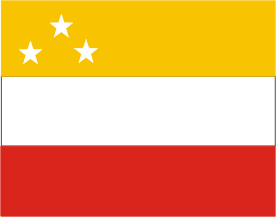
image by Jaume Ollé, 5 October 2003
No. 1040 - Colombia - Obsolete [Unknown to me. I believe that
the central stripe must be light blue].
Source: [stb].
Jaume Ollé, 5 October 2003

image by Jaume Ollé, 26 October 2003
No. 1114 - Colombia - Obsolete [Obsolete and wrong, the green
must be yellow, the blue lighter].
Source: [stb].
Jaume Ollé, 26 October 2003
Almost a year ago, Dov Gutterman found in the web of
the colombian presidency a page with a short synopsis of the
colombian flag history at <www.presidencia.gov.co>
and it contains 16 flags with a short explanation of each one of
them. I had drawn most of those flags .Here is also a translation
of the info at that page. My comments are between brackets.
Jorge Candeias, 1 October 1999
prein.gif)
image by Jaume Olle, 15 September 2001
Until 1810 only spanish flags were used in Nueva Granada. But
the so-called Kingdom of New Grenada had arms granted by King of
Castilla and Catalonia, Charles V, in Royal Cedule issued 3
December 1548. (A lot of cities also obtained arms)
Jaume Olle, 15 September 2001

image by Jorge Candeias, 1 October 1999
From <www.presidencia.gov.co>:
"Designed by Francisco Mirando [isn't it Miranda?, JC] in
1797, referring to the social classes and to the four fundamental
aims the patriots aspired to: equality, liberty, property and
safety. " [this is the tetracolour flag also used today as
the state flag of Vargas, Venezuela. It
can be described like this: Divided vertically into two equal
fields. The hoist field is white with a blue horizontal stripe
1/4 height along the bottom. The white part is charged by a red
sun; the blue stripe is charged with 4 white 5-pointed stars. The
fly half is divided into 4 vertical stripes, yellow, red, white,
blue. The overall proportions look like 1:2].
Jorge Candeias, 1 October 1999
Editorial note: According to other source, this reported flag is wrong and the right flag is the flag that is used today by Vargas state, Venezuela, as described there.

image by Eugene Ipavec, 2 January 2008
Colombia and Venezuela use to be one single country in the
beggining. As such they have many symbols in common. One of them
is the 1797 flag shown here. It was the same symbol used by both
countries and then, only one country, Virreinato de Nueva
Granada, or ViceRoyalty of New Grenada.
The image is based on a photo taken on Colombian Independence
Day, July 20, 2006 in Bogota.
E.R., 2 January 2008

image by Guillermo Aveledo , 7 September 1999
From <www.presidencia.gov.co>:
"This was the emblem of the brigantine Leandro when it was
put in the water at 12 March 1806. This flag was the symbol of
victory "- [blue with a full moon centered and a raising sun
in the canton. A long and narrow red streamer flies above the
flag with no identifiable writing. In the original file there
seems to be something in lower hoist and details are very
difficult to resolve. The overall proportions seem to be about
2:3, excluding the streamer.]
Jorge Candeias, 1 October 1999
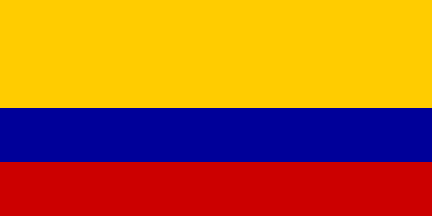
image by Jorge Candeias, 1 October 1999
From <www.presidencia.gov.co>:
"At 12 March 1806, our national tricolour was flown for the
first time. Miranda was inspired by the predominant colours of
the rainbow [?] and it was flown on land in the port of La Vela
in August of the same year" [It is the colombian
yellow-blue-red horizontal in 2:1:1. Judging by that drawing, it
was 1:2].
Jorge Candeias, 1 October 1999
About the red flag loaded with a white rhombus and
simultaneously this one with a blue rectangle, I must comment
that I don’t know it with that exact description,
nevertheless, several sources speak of a similar flag that only
difference in which the blue rectangle, is not blue nor green
(like the Italian of 1802-1805) but is black. About this flag
Luis A. Bohórquez says: "On July 15th, Bolivar decreed on
Trujillo (Venezuela) the War until Death to the Spaniards and
created the respective flag". If I don’t interpret
badly, Bohórquez attributes to Bolivar the creation of this
flag, fact that contradicts what it has been argued in this forum
about the paper of Bolivar as flag designer. Then, we remember
that Bolivar visited Italy on 1805, time of the Italian flag
similar to the one of our exposition, and that he was present the
Napoleon’ coronation and did there his very well known oath
on Monte Sacro. Would be inspired Bolivar on the Italian flag of
that time when he decreed War until Death to the Spaniards?
Given the facts, it could well have happened this way. Perhaps,
he wanted to offer a tribute to Italy when he arrived to
Trujillo, then could think that he had fulfilled his oath. By
another part, is also says that admiral Padilla used the flag of
the white rhombus.
Eduardo Garcia Perdomo, 13 July 2005
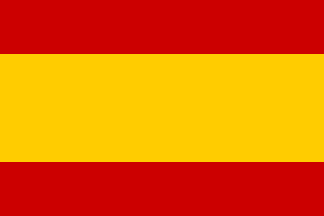
image by Jorge Candeias, 1 October 1999
From <www.presidencia.gov.co>:
"Red and gold of Carlos III. It's colours symbolize the
military notion in the orders of his majesty for the regime,
discipline, subbordination and services of his armies, effective
since the time of D. Carlos III ".[This is the spanish
triband. I'm not sure I understood the original text, so this
translation may contain errors. Anyway, this image should, I
suppose, contain the arms of Spain from that period, as depicted
in the Spanish pages. Proportions,
2:3].
Jorge Candeias, 1 October 1999

image by Jorge Candeias, 1 October 1999
From <www.presidencia.gov.co>:
"In 1811 the predecessor [?! I suppose they refer to
Miranda] leaded the mantuans [?!] under a big yellow banner, used
by the armies in the Liberating Campaign of 1819" [A plain
yellow flag with 2:3 proportions].
Jorge Candeias, 1 October 1999
Confederate Cities in the Cauca Valley

image by Jorge Candeias, 1 October 1999
From <www.presidencia.gov.co>:
"This flag was adopted by the confederate cities in the
Cauca Valley, approved at 26 July 1811. The General Jose' Maria
Cabal took part in the delegation and his troops took the flag in
campaigns along the Palace' [this is a white over blue horizontal
bicolour, unlike the current flag of Cauca."
[Again, I'm not certain of my translation. The text is quite
confusing . Anyway, the proportions seem longer than 2:3. I made
it 1:2, perhaps exaggerating].
Jorge Candeias, 1 October 1999
Cauca Valley has a complicate history. First autonomist
movements started in July 1810. In August some cities created a
confederation for defense from the royalist that controlled
mainly Popayan and Pasto. More cities adhered to the
Confederation in September 1810. On October, Cali claimed that
the confederation would be recognized as separate province
(separate from Popayan). The flag - celest over white, was used
as cockarde, flag and band. On 5 February 1811 the confederation
didn't recognize the spanish regency government anyomore. Popayan
(royalist) was conquered on 1-4-1811 but royalist remained in
Pasto. On 21 June 1811 junta of Confederate cities established in
Popayan and flag was adopted on 26 June 1811. It was celest over
white and fringed argent in at least three sides. It was used as
band, flag and coackarde. Confederation lost and reconquist
Popayan for several times (even conquered Pasto for some time),
and first obtained help from the United Provinces and after 1813
(with a previous small help in 1811) from Cundinamarca. The
dictatorship of Cundinamarca, Nari?o, was capturated by royalist
in this war, when leading cundinamarquese troops in help of the
confederates. At the end royalist defeated the independentist and
in 1816 the confederation ended and spanish rule restablished as
was in rest of provinces except Casanare, where the
independentist resistence, led by Santander, and helped soon by
Venezuela, started to recover the country.
Jaume Ollé, 15 September 2001

image by Eugene Ipavec, 6 january 2008
The flag featured as the CIudades Confederadas has the blue
color wrong. It must have the same shade of blue as the Department of Valle flag and in the same
description, celestial (light) blue over white.
E.R., 4 January 2004
Cundinamarca Regiments Flag
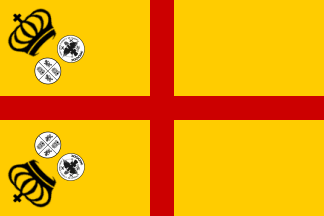
obverse
image by Eugene Ipavec and Jorge Candeias, 30
May 2006

reverse
image by Jorge Candeias, 30 May 2006
From <www.presidencia.gov.co>:
"From the regiments of Cundinamarca of 1811 the government
decreed that the flag should be yellow with a red cross and it
it's corners the shields of Cundinamarca, Castille and Leon. It
was held by Narin~o in all his campaigns." [my image is just
a sketch, since it is impossible from the original file to know
where should be placed each of the shields. Anyway, they are in
the hoist quadrants (more specific than "corners"). The
source shows a long flag, so I made it 1:2].
Jorge Candeias, 1 October 1999
In a recent Military parade held in Bogota this year to
commemorate Colombia's Independence Day (July 20), all the
historical Colombian flags were flown. According to my sources (a
booklet from the Military Museum in Bogota and also the pictures
taken from the TV broadcast that day), the flag (ratio 2:3)
should be called Bandera de los Regimientos de Cundinamarca
(Cundinamarca Regiments flag). The obverse of the flag should be
yellow background and the red stripes (one vertical and one
horizontal), just like it is shown here and on the top left
corner clockwise there is the Crown of Spain, the arms of the State of Cundinamarca and
the arms of Castilla and León
encircled. On the bottom left corner the same composition. From
what I saw on the pictures, all of the Coats of Arms depited on
this flag are outlined (in black and white).
This flag was carried by Colombian General Anotnio Nariño in all
his campaigns against the Spaniards.
The reverse of the flag is the yellow background and the red
stripes (one vertical and one horizontal).
At that time Colombia was divided among Centralists (State of
Cundinamarca and its allies) and the Federalists (Provincias
Unidas de Nueva Granada), two rival government entities that even
fought a civil war. This period is known as "La Patria
Boba" (The dumb fatherland) because due to the internal
conflict it was rather easy for Spain to reconquer in 1816 the
territory that had declared independence on July 20, 1810.
E.R, 6 March 2006 and 30 May 2006
Cartagena
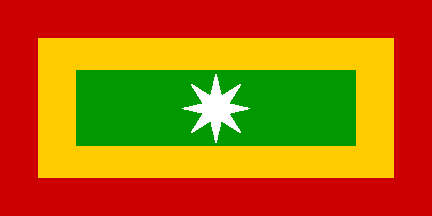
image by Jorge Candeias, 1 October 1999
From <www.presidencia.gov.co>:
"Flag of Cartagena. At 17 November 1811, it [the flag, I
presume] received an oath of loyalty from the troops gathered
there. Bolivar took it in the Admirable Campaign in 1813, using
it Atanasio Girardot did the feat of the _Barbula_. It was
adopted as emblem in April 1814 by the Congress of the united
provinces of Nueva Granada" [The flag is green (?) with a
yellow inner border and a red outer border and a white 8-pointed
star centered. The green is highly dubious. The colour of the
original is not clear, but is distinctly greenish. I suspect,
however, that it should be blue instead, as in all other
colombian flags I know of. I'm posting the green
"version" anyway. Also a long flag in the original
drawing, so I made it 1:2, probably exagerating].
Jorge Candeias, 1 October 1999
See also: Cartagena State (1811-1814) and Cundinamarca Independent State (1813-1814)
From <www.presidencia.gov.co>:
"Ninth flag - Of an independent
Cundinamarca. In the year 1814 was adopted as a symbol of Nueva
Granada and ment a second act of conversion of the tricolour.
Nation corresponding to the identity of heroic aims and ideals of
Nariño, Miranda and Bolivar"[The flag is a tricolour of
blue, yellow and red, with equal horizontal stripes and with an
oval centered charged with what looks like an eagle.
Jorge Candeias, 1 October 1999

image by Jorge Candeias, 1 October 1999
From <www.presidencia.gov.co>:
"At 26 April the Congress gathered in Tunja adopts it as
symbol of the united provinces of Nueva Granada. Later it was
adopted as banner of the city of Buga. "[this one is a plain
horizontal tricolour with equal heights, yellow, green (?), red.
Proportions definitely 1:2].
Jorge Candeias, 1 October 1999

image by Jorge Candeias, 1 October 1999
From <www.presidencia.gov.co>:
"Of the Bolivarine lancers. Designed by the liberator Simon
Bolivar and carried by his troops during the campaign of War to
Death [this is a blue triangular flag with white writing reading
"LIBERTAD O MUERTE" (freedom or death)]
Jorge Candeias, 1 October 1999

image by Jorge Candeias, 1 October 1999
From <www.presidencia.gov.co>:"This
one continues the flag of War to Death and the troops carried it
from 1814 upto the battles of the Vargas swamp and Boyaca' bridge
that established definitively our independence" [this one is
clearly based on napoleonic designs: red with a large white
lozenge including a blue rectangle. Another long flag, but again
I might have exagerated by making it 1:2].
Jorge Candeias, 1 October 1999

image by Jaume Ollé, 15 September 2001

image by Jaume Ollé, 15 September 2001

image by Jaume Ollé, 15 September 2001
In 1819 campaign there was mainly using the Miranda flag, that
was yellow, blue and red (4:2:1) but also was used the flag of
Padilla, a pirate chef that in1813, leading Cartagena military
forces, helped Bolivar in the so-called "war at death"
against spanish in 1813. The Padilla flag is only reported with
date 1819 and is red with white losange containing a black
rectangle.Flagmaster picture it with yellow losange, but seems to
be another mistake.
Jaume Ollé, 15 September 2001
See also: United Provinces on New Granada (1814)
See: Great Colombia Federate Republic (1819-1830)
See: Great Colombia Federate Republic (1819-1830)
See: New Granada Republic (1831-1856)